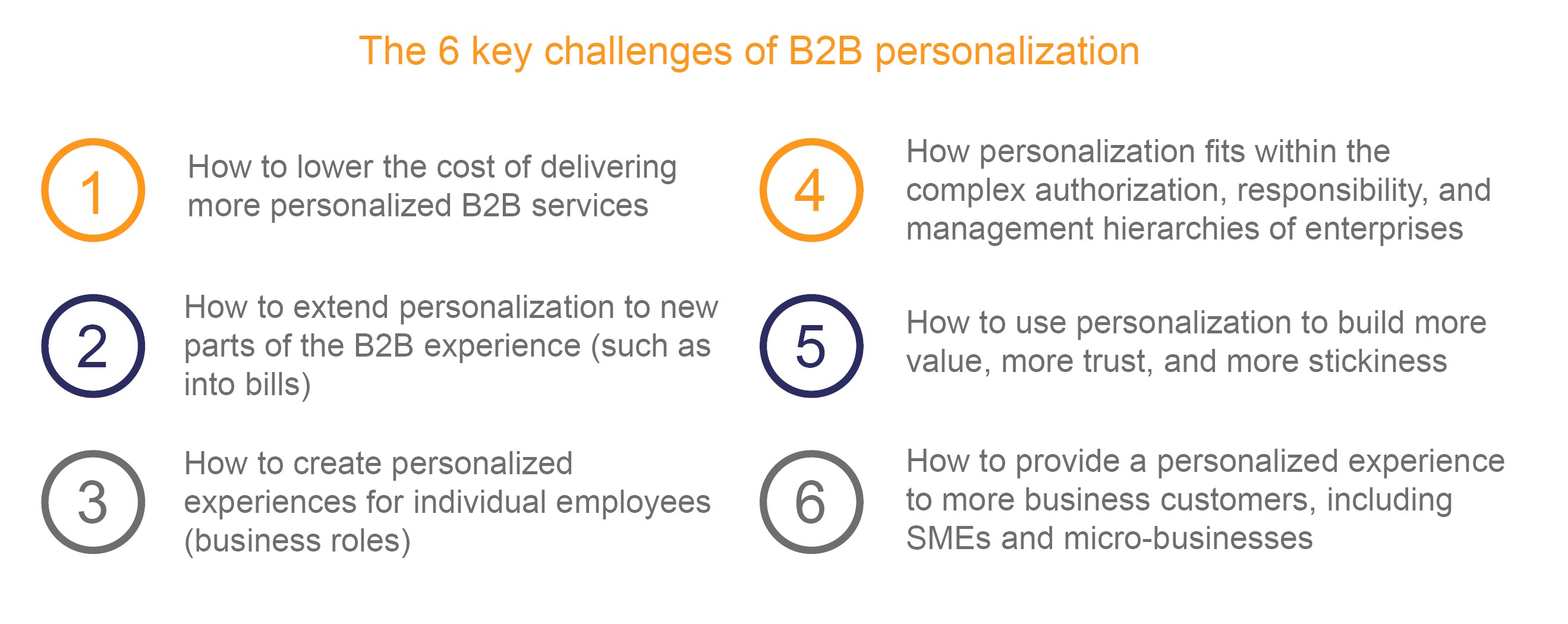How personalization unlocks the full value of the B2B billing experience
27 January 2022
|
Laura Broers
The high value of large enterprise customers has meant that CSPs have long used a highly personalized and bespoke approach to supporting them. But as the business market changes and new employee expectations emerge, Laura Broers looks at how personalization methods can be utilized to refresh the B2B experience.
Personalization – creating an individualized experience - can be viewed as an example of simplification, because it reduces complexity for customers by removing extraneous information and choices and making it easier for them. It is often regarded as a B2C concept, a tactic for improving the experience of consumers, but it’s existed for a long time in the B2B market.
In fact, CSPs have long utilized a highly personalized or individualized approach to managing their largest enterprise customers. This includes using dedicated account managers, tailoring services to the customer’s specific needs, creating individualized pricing, offers & discounts, and providing customized support.
The limitations of the traditional approach
The traditional bespoke approach CSPs have taken to personalizing their enterprise offering has challenges and weaknesses:

Why bother personalizing the B2B experience?
What’s new in B2B personalization is that the cost of delivering it is being reduced, its scope is widening to include smaller businesses, and its extent is deepening to incorporate individual roles (such as business users, budget holders and finance officers) and more parts of the customer journey.
If CSPs can get this right, it creates a win-win for both themselves and their business customers. The CSP can attract spending away from rival operators by building trust and highlighting where enterprises can save money or benefit from additional services. The enterprise can meet its own goals in both direct and indirect ways. Personalization can help:
- reduce the cost of processing bills
- help meet accessibility obligations, by ensuring all employees easily understand and can manage their bills
- support green targets by providing insight into how employee ICT choices impact their carbon footprint
- boost employee experience (EX) by making it less onerous to deal with bills
B2B personalization presents 6 key challenges
Although personalization has been around in the B2B market for a long time, it is harder to deliver than in the B2C market. B2B CSPs face six key challenges when implementing personalization:

Importantly, personalization differs in B2B because there are multiple ‘customers’. It means not only addressing the needs of an individual employee, but also understanding how changes get authorized (who the budget holder is or the cost center manager), and beyond that providing information to those who are responsible for managing costs across the enterprise (the accounts department or senior managers). This means understanding the hierarchy within the business, which might be relatively flat in a SME, but quite complex in a large enterprise.
Where to start with personalization?
Identifying where generic experiences can be personalized to increase business value or improve the employee experience starts with making it easier for enterprises to manage their bills – for example, by offering predefined bill templates from which a bill user can choose, such as a PDF with only bill summary and highlights (without bill details and CDRs); a PDF with all bill information (including CDRs); a PDF with costs grouped by cost type and products; a PDF with costs grouped by location or department. CSPs can also provide functions to help enterprises manage their costs - such as easier drill downs and configurable usage caps & alerts - which help cost center managers keep control of their budgets, making their lives easier.
Personalization also isn’t something that’s done to a customer though, but rather something that’s co-created with them. Providing enterprise customers with more self-care capabilities enables them to self-configure their experience, delivering the consumer-like experience and level of control that smaller businesses and younger business users desire. In B2B environments this is more complex than in B2C, because the ability to make changes to service packages or configuration controls might not be available to all roles, but just to those with the authority to make changes (ie the cost center manager).
Realtime balances are another capability that can support personalization efforts by offering employees realtime insight into their spending and alerts to help them stay in control and thereby avoid embarrassing conversations with their managers. But they’re also valuable to those controlling costs, because they help them to better understand the enterprise’s liabilities and intervene before costs spiral out of control (either by shifting the employee to a more appropriate package or speaking to them about their usage).
The concept of personalization is not just applicable in B2C contexts but is also important to meet the needs of business customers and their employees. Reach out if you want to learn more about B2B personalization!
Contact us






